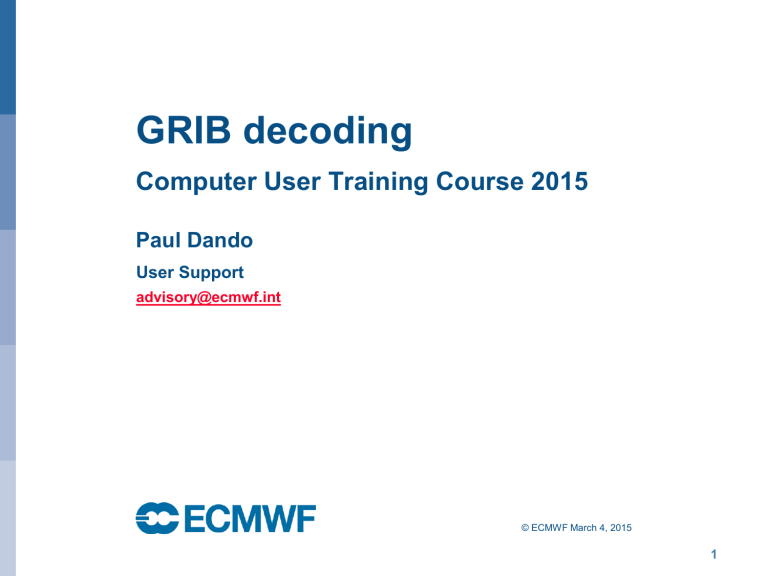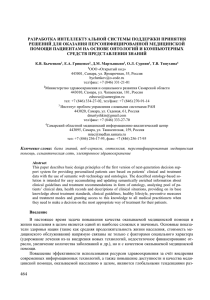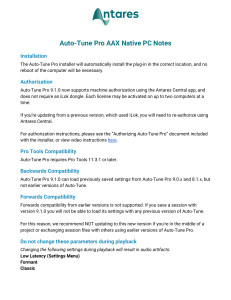
GRIB decoding
Computer User Training Course 2015
Paul Dando
User Support
advisory@ecmwf.int
© ECMWF March 4, 2015
1
Contents
GRIB description and overview
- GRIB edition 1 and GRIB edition 2
- Major differences between GRIB edition 1 and 2
- Status of ECMWF migration to GRIB edition 2
Using GRIB Tools
- Introduction to GRIB API
- Inspecting the content of GRIB messages
- Decoding GRIB messages
- Manipulation of GRIB messages
Decoding GRIB messages with Fortran 90 … and Python
COM INTRO: GRIB Decoding © ECMWF 2015
2
GRIB
GRIB – “General Regularly-distributed Information in Binary form”
Code defined by the WMO / CBS in 1985
Designed to exchange and store large volumes of gridded data
Machine independent
Requires software for encoding and decoding
Currently there are two different coding standards
GRIB edition 1
- Currently used for ECMWF operational surface and pressure level
data
GRIB edition 2
- Recent format now being used by some centres and for the
TIGGE archive
- Used for ECMWF operational model level data since 18 May 2011
COM INTRO: GRIB Decoding © ECMWF 2015
3
GRIB edition 1 overview
Main feature of GRIB is that data descriptors are self-defining
Section 0 – Indicator section
Section 1 – Product definition section
Section 2 – [ Grid description section ]
Section 3 – [ Bit map section ]
Section 4 – Binary data section
Section 5 – 7777 (End of GRIB message)
In the above [ ] indicates an optional section
COM INTRO: GRIB Decoding © ECMWF 2015
4
GRIB Structure
A file may contain one or more GRIB messages
Each message contains several sections
Note: A file can contain a mix of editions 1 and 2
File: eps.grib
Message #1
Section 0: Indicator
Message #2
Section 1: Product Def
Message #3
…
…
Section 4: Binary Data
Section 5: End
Message #N
COM INTRO: GRIB Decoding © ECMWF 2015
5
GRIB 1 & GRIB 2 – Different Structure
GRIB 1
GRIB 2
SECTION 0 Indicator
SECTION 1 Product Definition
SECTION 1 Identification
SECTION 2 [ Grid Description ]
SECTION 2 [ Local Use ]
SECTION 3 [ Bitmap ]
SECTION 3 Grid Definition
SECTION 4 Binary Data
SECTION 4 Product Definition
repeat
SECTION 0 Indicator
SECTION 5 End (7777)
SECTION 5 Data Representation
SECTION 6 Bitmap
SECTION 7 Binary Data
Optional sections are
indicated by [ ]
SECTION 8 End (7777)
COM INTRO: GRIB Decoding © ECMWF 2015
6
GRIB 1 & GRIB 2 – Major differences
The coding principles for GRIB edition 1 and 2 are similar but
their implementation is very different
The structure of GRIB 1 and GRIB 2 messages is different
- Both have sections but with different meanings
In GRIB 2 several variables are defined with more precision
- In GRIB 1 latitudes and longitudes are in milli-degrees
- In GRIB 2 latitudes and longitudes are in micro-degrees
In GRIB 2 longitude values must lie between 0˚ and 360˚
Encoding of the parameter is very different
In GRIB 2 the description of the data (parameter, time,
statistics, grid…) is template / table based
- More flexible … but also more complex !
COM INTRO: GRIB Decoding © ECMWF 2015
7
Use of GRIB 2 at ECMWF
What is currently affected ?
Since 18 May 2011 all model level fields for HRES and ENS
(including the monthly extension) are encoded in GRIB 2
- GRIB 1 model level data are no longer produced or disseminated
Most surface and all pressure level fields are encoded in GRIB 1
- Some recently introduced surface fields are encoded in GRIB 2
Staged migration of remaining GRIB 1 fields to GRIB 2 will follow
And what’s not ?
The wave model
The System-4 seasonal forecast model
ERA-Interim
COM INTRO: GRIB Decoding © ECMWF 2015
8
Introducing GRIB API
GRIB API Library is an application programming interface
developed by ECMWF
GRIB API hides the binary layer of the message providing the
user with a higher level of access
It provides an easy and reliable way of encoding and
decoding both GRIB 1 and GRIB 2 messages
GRIB API decodes / encodes both GRIB editions with the
SAME function calls
Command line tools (the GRIB Tools) provide a quick and
easy way to manipulate data
Fortran 90, C and Python interfaces give access to the main
features of the library
COM INTRO: GRIB Decoding © ECMWF 2015
9
GRIB API approach
GRIB API uses a key / value approach to access the
information in a GRIB message
numberOfPointsAlongAParallel Number of points along a parallel
numberOfPointsAlongAMeridan Number of points along a meridian
…
The set of keys available changes from one message to
another depending on:
- the GRIB edition
- the content of the message
Changing the values of some keys can cause some other keys
to disappear and new keys to become available
COM INTRO: GRIB Decoding © ECMWF 2015
10
GRIB API – coded and computed keys
The value of a key is not always coded in the GRIB message
Some keys are combinations of several other keys and
provided through a given algorithm or can be just temporary
(transient)
Therefore we talk about
- CODED keys ( coded in the message as they are )
- COMPUTED keys ( temporary or computed from other keys )
Alternative names (“aliases”) are provided for several keys
COM INTRO: GRIB Decoding © ECMWF 2015
11
GRIB API – coded and computed keys
Coded keys
- Linked directly to the octets of the GRIB message
- Values obtained by decoding the octet e.g. indicatorOfParameter
Computed keys
- Obtained by combining other keys (coded or computed)
- Provide a synthesis of the information contained in the message
- Provide a convenient way to access complex attributes
- Setting the value of a computed key sets all related keys in a cascade
e.g. setting typeOfGrid=regular_ll will set all the various keys in
the Grid Definition Section for a regular lat-long grid
- MARS keywords are available as computed keys
COM INTRO: GRIB Decoding © ECMWF 2015
12
GRIB API keys – parameter
The definition of the parameter is very different in the two
editions
GRIB 1 keys
GRIB 2 keys
centre
discipline
table2Version
parameterCategory
indicatorOfParameter
parameterNumber
levelType
typeOfFirstFixedSurface
level
scaleFactorOfFirstFixedSurface
…
scaledValueOfFirstFixedSurface
typeOfSecondFixedSurface
scaleFactorOfSecondFixedSurface
scaledValueOfSecondFixedSurface
productDefinitionTemplateNumber
…
COM INTRO: GRIB Decoding © ECMWF 2015
13
GRIB API keys – parameter
GRIB API provides some edition-independent keys to identify
a parameter
Key name
Example value
paramId
151
shortName
msl
centre
ecmf (or 98)
name
Mean sea level pressure
unit
Pa
This set of keys is the parameter namespace
COM INTRO: GRIB Decoding © ECMWF 2015
14
The parameter database
The parameter database stores information about the GRIB 1,
GRIB 2 and, for some parameters, netCDF encoding of all
parameters recognised by GRIB API
The database is accessible via a web interface at:
- http://old.ecmwf.int/publications/manuals/d/gribapi/param
COM INTRO: GRIB Decoding © ECMWF 2015
15
GRIB API – namespace
A namespace is a name for a set of keys.
There are several different namespaces
- parameter
- time
- geography
- vertical
- statistics
- mars
COM INTRO: GRIB Decoding © ECMWF 2015
16
GRIB API keys – time
Start of forecast run
Key name
Example values
dataDate
20140305 (YYYYMMDD)
dataTime
0, 600, 1200, 1800
Forecast Step
Key name
Example values
stepType
instant, accum, avg, max, min, …
stepUnits
s, m, h, 3h, 6h, 12h, D, M, Y, 10Y, 30Y, C
startStep
0, 3, …
endStep (= step)
0, 3, ..
stepRange
3-6, 6 (“startStep-endStep” , “endStep” )
Validity of the forecast
Key name
Example values
validityDate
20140305 (YYYYMMDD)
validityTime
0, 300, 1200, 1800
COM INTRO: GRIB Decoding © ECMWF 2015
17
GRIB API keys – MARS
There is a namespace consisting of all the MARS keywords
Key name
Example values
date
20140305 (YYYYMMDD)
time
0000, 0600, 1200, 1800
step
3, 6, 9, 12, …
class
od, …
stream
oper, enfo,…
expver
0001
type
an, fc, cf, pf, …
levtype
sfc, pl, ml
levelist
500, 850, …
param
151.128
COM INTRO: GRIB Decoding © ECMWF 2015
18
GRIB API keys – THE Reference
GRIB 1 keys
http://old.ecmwf.int/publications/manuals/d/gribapi/fm92/grib1/
GRIB 2 keys
http://old.ecmwf.int/publications/manuals/d/gribapi/fm92/grib2/
Edition independent keys
http://old.ecmwf.int/publications/manuals/d/gribapi/keys/
Use edition independent keys where possible !
Slide 19
COM INTRO: GRIB Decoding © ECMWF 2015
19
GRIB API keys
The easiest way to inspect a GRIB file and to find the keys
available is to use the GRIB Tools
- grib_ls
to get a summary of the content
- grib_dump
to get a more detailed view
COM INTRO: GRIB Decoding © ECMWF 2015
20
GRIB Tools – basic concepts
The GRIB tools are part of the ECMWF GRIB API Library
They are a set of command line programs for interactive and
batch decoding and processing of GRIB data
They provide ready and tested solutions to the most common
processing of GRIB data
- They work with both GRIB edition 1 and GRIB edition 2
Their use will avoid the need to write new code and thus
speed up your work
- Consider using GRIB Tools instead of writing your own
programs
The tools are provided with many common options so that it
is quick to apply the same options to different tools
Use of the tools is recommended whenever possible !
COM INTRO: GRIB Decoding © ECMWF 2015
21
GRIB Tools – more basics
All of the tools use a common syntax
grib_<tool> [options] grib_file grib_file … [output_grib]
There are tools for getting information about the GRIB API
installation and the keys available
- grib_info, grib_keys
There are tools to inspect the content of and compare GRIB
messages
- grib_ls, grib_dump, grib_get, grib_get_data, grib_compare
There are tools for counting and copying some messages
- grib_count, grib_copy
There are tools for making changes to the content of a GRIB
message and converting GRIB to netCDF
- grib_set,
grib_filter, grib_to_netcdf
COM INTRO: GRIB Decoding © ECMWF 2015
22
GRIB Tools – getting help
UNIX ‘man’-style pages are available for each tool by running
the tool without any options or input file
> grib_dump
NAME
grib_dump
DESCRIPTION
Dump the content of a grib file in different formats.
USAGE
grib_dump [options] grib_file grib_file ...
OPTIONS
-O
-D
-d
Octet mode. WMO documentation style dump.
Debug mode.
Print all data values.
…
COM INTRO: GRIB Decoding © ECMWF 2015
23
grib_ls – list the content of GRIB files
Use grib_ls to get a summary of the content of GRIB files
Without options grib_ls prints a default list of keys
Options exist to specify the set of keys to print or to print
other keys in addition to the default set
Output can be ordered
- e.g. order by ascending or descending step
grib_ls does not fail if a key is not found
grib_ls can also be used to find the grid point(s) nearest to a
specified latitude-longitude and print the value of the field at
that point
-
Modes available to obtain one or four nearest grid points
COM INTRO: GRIB Decoding © ECMWF 2015
24
grib_ls – usage
grib_ls [options] grib_file grib_file ...
Basic options
-p key1,key2,…
Keys to print
-P key1,key2,…
Additional keys to print
-w key1=val1,key2!=val2…
Where option
-B “key asc, key desc”
Order by: “step asc, centre desc”
-n namespace
Print keys for namespace
-m
Print MARS keys
-i index
Print data value at given index
-l lat,lon[,MODE,FILE]
Value(s) nearest to lat-lon point
-F format
Format for floating point values
-W width
Minimum column width (default 10)
COM INTRO: GRIB Decoding © ECMWF 2015
25
grib_ls – examples
> grib_ls file.grib1
file.grib1
edition centre typeOfLevel level
1
ecmf
isobaricInhPa 1000
1
ecmf
isobaricInhPa 500
1
ecmf
isobaricInhPa 200
1
ecmf
isobaricInhPa 100
4 of 4 grib messages in file.grib1
dataDate
20140304
20140304
20140304
20140304
... dataType
... an
... an
... an
... an
shortName
t
t
t
t
packingType gridType
spectral_complex sh
spectral_complex sh
spectral_complex sh
spectral_complex sh
4 of 4 total grib messages in 1 files
Use –p option to specify a list of keys to be printed
> grib_ls –p centre,dataDate,shortName,paramId,typeOfLevel,level file.grib1
file.grib1
centre
dataDate
shortName
ecmf
20140304
t
ecmf
20140304
t
ecmf
20140304
t
ecmf
20140304
t
4 of 4 grib messages in file.grib1
paramId
130
130
130
130
typeOfLevel
isobaricInhPa
isobaricInhPa
isobaricInhPa
isobaricInhPa
level
1000
500
200
100
4 of 4 total grib messages in 1 files
COM INTRO: GRIB Decoding © ECMWF 2015
26
grib_ls – examples
When a key is not present in the GRIB file, it returns “not
found” for this key
> grib_ls –p my_key
file.grib1
my_key
not_found
> echo $?
0
file.grib1
exit code returned = 0
Similar behaviour to grib_get (see later)
- grib_ls is more for interactive use
- use grib_get within scripts
COM INTRO: GRIB Decoding © ECMWF 2015
27
Using the ‘where’ option
The where option –w can be used with all the GRIB Tools
Constraints are of the form key=value or key!=value or
key=value1/value2/value2
-w key1=value1,key2:i!=value2,key3:s=value3
Messages are processed only if they match ALL the key /
value constraints
> grib_ls –w level=100 file.grib1
…
> grib_ls –w level!=100 file.grib1
“IS”
“NOT”
…
> grib_ls –w level=100,stepRange=3 file.grib1
“AND”
…
> grib_ls –w level=100/200/300/500 file.grib1
“OR”
…
COM INTRO: GRIB Decoding © ECMWF 2015
28
Specifying the type of the key
All grib_api keys have a default type
- e.g. string, integer, floating point
The type of the key can be specified as follows:
- key
-> native type
- key:i
-> integer (or key:l - the “el” is for “long” !)
- key:s
-> string
- key:d
-> double
> grib_ls –p centre:i,dataDate,shortName,paramId,typeOfLevel,level file.grib1
file.grib1
centre
98
98
98
98
4 of 4 grib
dataDate
20140304
20140304
20140304
20140304
messages in
shortName
t
t
t
t
file.grib1
paramId
130
130
130
130
typeOfLevel
isobaricInhPa
isobaricInhPa
isobaricInhPa
isobaricInhPa
level
1000
500
200
100
4 of 4 total grib messages in 1 files
COM INTRO: GRIB Decoding © ECMWF 2015
29
grib_dump – dump content of GRIB files
Use grib_dump to get a detailed view of the content of a file
containing one or more GRIB messages
Various output formats are supported
- Octet mode provides a WMO documentation style dump
- Debug mode prints all keys available in the GRIB file
- Octet and Debug modes cannot be used together
- Octet content can also be printed in hexadecimal format
Options also exist to print key aliases and key type information
COM INTRO: GRIB Decoding © ECMWF 2015
30
grib_dump – usage
grib_dump [options] grib_file grib_file ...
Basic options
-O
Octet mode (WMO Documentation style)
-D
Debug mode
-a
Print key alias information
-t
Print key type information
-H
Print octet content in hexadecimal
-w key{=/!=}value,…
Where option
-d
Print all data values
...
COM INTRO: GRIB Decoding © ECMWF 2015
31
grib_dump – examples
> grib_dump file.grib1
***** FILE: file.grib1
#==============
MESSAGE 1 ( length=4284072 )
==============
GRIB {
editionNumber = 1;
table2Version = 128;
# European Center for Medium-Range Weather Forecasts (grib1/0.table)
centre = 98;
generatingProcessIdentifier = 141;
# Geopotential (m**2 s**-2) (grib1/2.98.128.table)
indicatorOfParameter = 129;
# Surface (of the Earth, which includes sea surface) (grib1/3.table)
indicatorOfTypeOfLevel = 1;
level = 0;
# Forecast product valid at reference time + P1 (P1>0) (grib1/5.table)
timeRangeIndicator = 0;
# Unknown code table entry (grib1/0.ecmf.table)
subCentre = 0;
paramId = 129;
#-READ ONLY- units = m**2 s**-2;
#-READ ONLY- nameECMF = Geopotential;
#-READ ONLY- name = Geopotential;
decimalScaleFactor = 0;
dataDate = 20140304;
dataTime = 0; …
Some keys are
read only
keys are case sensitive:
dataDate, dataTime
COM INTRO: GRIB Decoding © ECMWF 2015
32
grib_dump – examples
> grib_dump –O file.grib1
***** FILE: file.grib1
==============
MESSAGE 1 ( length=4284072 )
==============
1-4
identifier = GRIB
5-7
totalLength = 4284072
8
editionNumber = 1
====================== SECTION_1 ( length=52, padding=0 ) ======================
1-3
section1Length = 52
4
table2Version = 128
5
centre = 98 [European Center for Medium-Range Weather Forecasts
(grib1/0.table) ]
6
generatingProcessIdentifier = 141
7
gridDefinition = 255
8
section1Flags = 128 [10000000]
9
indicatorOfParameter = 129 [Geopotential (m**2 s**-2)
(grib1/2.98.128.table) ]
10
indicatorOfTypeOfLevel = 1 [Surface (of the Earth, which includes sea
surface) (grib1/3.table) ]
11-12
level = 0
13
yearOfCentury = 14
14
month = 3
15
day = 4
16
hour = 0
17
minute = 0
18
unitOfTimeRange = 1 [Hour (grib1/4.table) ] …
COM INTRO: GRIB Decoding © ECMWF 2015
33
grib_dump – examples
> grib_dump -OtaH
file.grib1
***** FILE: file.grib1
==============
MESSAGE 1 ( length=4284072 )
==============
1-4
ascii identifier = GRIB ( 0x47 0x52 0x49 0x42 )
5-7
g1_message_length totalLength = 4284072 ( 0x41 0x5E 0xA8 )
8
unsigned editionNumber = 1 ( 0x01 ) [ls.edition]
====================== SECTION_1 ( length=52, padding=0 ) ======================
1-3
section_length section1Length = 52 ( 0x00 0x00 0x34 )
4
unsigned table2Version = 128 ( 0x80 ) [gribTablesVersionNo]
5
codetable centre = 98 ( 0x62 ) [European Center for Medium-Range Weather
Forecasts (grib1/0.table) ] [identificationOfOriginatingGeneratingCentre,
originatingCentre, ls.centre, centreForTable2]
6
unsigned generatingProcessIdentifier = 141 ( 0x88 )
[generatingProcessIdentificationNumber, process]
7
unsigned gridDefinition = 255 ( 0xFF )
8
codeflag section1Flags = 128 [10000000] ( 0x80 )
9
codetable indicatorOfParameter = 129 ( 0x81 ) [Geopotential (m**2 s**-2)
(grib1/2.98.128.table) ]
10
codetable indicatorOfTypeOfLevel = 1 ( 0x01 ) [Surface (of the Earth,
which includes sea surface) (grib1/3.table) ] [levelType, mars.levtype]
11-12
unsigned level = 0 ( 0x00 0x00 ) [vertical.topLevel,
vertical.bottomLevel, ls.level, lev]
13
unsigned yearOfCentury = 14 ( 0x0E )
14
unsigned month = 3 ( 0x03 )
15
unsigned day = 4 ( 0x04 ) …
COM INTRO: GRIB Decoding © ECMWF 2015
34
Practicals
Work in your $SCRATCH
cd $SCRATCH
Make a copy of the practicals directory in your $SCRATCH
tar –xvf /scratch/ectrain/trx/grib_practicals.tar
This will create a directory in your $SCRATCH containing the
GRIB data files for all today’s practicals
There are sub-directories for each practical:
ls $SCRATCH/grib_practicals
practical1 practical2 practical3
practical4 practical5 practical6
COM INTRO: GRIB Decoding © ECMWF 2015
35
Practical 1: using grib_ls and grib_dump
1.
2.
Use grib_ls to inspect the content of the files msl.grib1 and
msl.grib2
-
Which keys does grib_ls show by default ?
-
What fields do the GRIB messages contain ?
-
Print the MARS keys. Add the shortName to the output
-
Order the output in descending step order
Use grib_ls to print the centre, dataDate, stepRange,
typeOfLevel and shortName for forecast step 6 only
-
3.
Output the centre as both a string and an integer
Use grib_dump to inspect the fourth (count=4) GRIB
message in both files
-
Experiment with the different grib_dump options: -O, -a and –t
-
Identify the parameter, date, time, forecast step and the grid geometry
COM INTRO: GRIB Decoding © ECMWF 2015
36
GRIB Examiner (Metview 4)
Interactive examiner using GRIB API
Actively developed and maintained by the Metview team
Can be started up from the command line. E.g. on ecgate use
metview4 -e grib your_grib_file
COM INTRO: GRIB Decoding © ECMWF 2015
37
GRIB Examiner: The user interface
File
information
Meta data
(grib_dump)
Message list
(with user
defined GRIB
API key
selection)
Log
COM INTRO: GRIB Decoding © ECMWF 2015
38
GRIB Examiner: managing GRIB API keys
Insert/edit keys
from header
menu
Drag and
drop a new
key
COM INTRO: GRIB Decoding © ECMWF 2015
39
Finding nearest grid points with grib_ls
The value of a GRIB field close to a specified
Latitude/Longitude point can be found with grib_ls
grib_ls –l Latitude,Longitude[,MODE,file] grib_file
MODE Can take the values
4
1
file
Print values at the 4 nearest grid points (default)
Print value at the closest grid point
Specifies a GRIB file to use as a mask
The closest land point (with mask ≥ 0.5) is printed
GRIB files specified must contain grid point data
COM INTRO: GRIB Decoding © ECMWF 2015
40
Practical 2: using grib_ls –l
1.
The file msl.grib1 contains the mean sea-level pressure from
the EPS control forecast at 6-hourly time steps for the first
24 hours on a N320 reduced Gaussian grid
2.
Find the value of the MSLP at the grid point nearest to
ECMWF (Lat 51.42°N, Lon 0.95° W) at each forecast step
-
What is the lat-lon value of the grid point nearest to ECMWF ?
-
How far is the chosen grid point from ECMWF ?
3.
Change the command used to output only the forecast step
and the MSLP value at the nearest grid point
4.
Change the command to output the MSLP values at the four
grid points nearest to ECMWF
5.
Use the file lsm.grib1 to provide a land-sea mask
-
Are all four nearest grid points land points (mask ≥ 0.5) ?
COM INTRO: GRIB Decoding © ECMWF 2015
41
grib_get – get key / value pairs
Use grib_get to get the values of one or more keys from one or
more GRIB files – very similar to grib_ls
By default grib_get fails if an error occurs (e.g. key not found)
returning a non-zero exit code
- Suitable for use in scripts to obtain key values from GRIB
messages
- Can force grib_get not to fail on error
Options available to get all MARS keys or all keys for a
particular namespace
- Can get other keys in addition to the default set
Format of floating point values can be controlled with
a C-style format statement
COM INTRO: GRIB Decoding © ECMWF 2015
42
grib_get – usage
grib_get [options] grib_file grib_file ...
Options
-p key1,key2,…
Keys to get
-P key1,key2,…
Additional keys to get with –m, -n
-w key1=val1,key2!=val2,…
Where option
-s key1=val1,…
Keys to set
-n namespace
Get all keys for namespace
-m
Get all MARS keys
-l lat,lon[,MODE,FILE]
Value(s) nearest to lat-lon point
-F format
Format for floating point values
-f
Do not fail on error
...
COM INTRO: GRIB Decoding © ECMWF 2015
43
grib_get – examples
To get the centre of the first (count=1) GRIB message in a
file (both as a ‘string’ and a ‘long’)
> grib_get –w count=1 –p centre f1.grib1
ecmf
> grib_get –w count=1 –p centre:i f1.grib1
98
grib_get fails if there is an error
> grib_get -p mykey f1.grib1
GRIB_API ERROR
: Key/value not found
> echo $?
246
returns the exit code from
the previous command
COM INTRO: GRIB Decoding © ECMWF 2015
44
grib_get – examples
To get all the MARS keys, optionally printing the shortName
> grib_get –m f1.grib1
g sfc 20150223 1200 0 167.128 od an oper 0001
> grib_get –m –P shortName f1.grib1
2t g sfc 20150223 1200 0 167.128 od an oper 0001
To get all keys belonging to the statistics namespace
> grib_get -n statistics f1.grib1
314.24 214.613 277.111 21.0494 41379.8 2.48314e-05 0
grib_get –m is the same as grib_get –n mars
COM INTRO: GRIB Decoding © ECMWF 2015
Slide 45
grib_get – controlling output format
The format of floating point values can be controlled by using
a C-style format statement with the –F option
-F “%.4f” - Decimal format with 4 decimal places (1.2345)
-F “%.4e” - Exponent format with 4 decimal places (1.2345E-03)
> grib_get –F “%.6f” –p maximum f1.grib1
314.240280
> grib_get –F “%.4e” –p maximum f1.grib1
3.1424e+02
Default format is -F “%.10e”
COM INTRO: GRIB Decoding © ECMWF 2015
46
grib_get – stepRange and stepUnits
The step is always printed as an integer value
By default the units of the step are printed in hours
To obtain the step in other units set the stepUnits
appropriately with the –s option
> grib_get –p stepRange f1.grib1
6
12
> grib_get –s stepUnits=m -p stepRange f1.grib1
360
stepUnits can be s, m, h, 3h, 6h, 12h, D, M, Y,
720
10Y, 30Y, C
COM INTRO: GRIB Decoding © ECMWF 2015
47
Finding nearest grid points with grib_get
The value of a GRIB field close to a specified
Latitude/Longitude point can be found with grib_get
- Works in the same way as grib_ls
> grib_get –l 52.0,-1.43 f1.grib1
273.58 272.375 273.17 273.531
> grib_get –F “%.5f” –P stepRange –l 52.0,-1.43,1 f1.grib1
0 272.37505
GRIB files specified must contain grid point data
COM INTRO: GRIB Decoding © ECMWF 2015
48
Getting data values at an index point
The value of a GRIB field at a particular index point can be
printed using grib_get with the –i option
For example, find the index of a nearest grid point with grib_ls
and then use this with grib_get to build a list of values at that
point:
> grib_get –F “%.2f” –i 2159 –p step,dummy:s f1.grib1
6 99429.31
12 99360.25
18 99232.31
24 99325.56
Forces a space
between step and
value
Also returns a value for non-grid point data !
COM INTRO: GRIB Decoding © ECMWF 2015
Slide 49
grib_get_data – print data values
Use grib_get_data to print a list of latitude, longitude (for grid
point data) and data values from one or more GRIB files
The format of the output can be controlled by using a C-style
format statement with the –F option
-F “%.4f” – Decimal format with 4 decimal places (1.2345)
-F “%.4e” – Exponent format with 4 decimal places (1.2345E-03)
The default format is -F “%.10e”
By default missing values are not printed
- A user-provided string can be printed in place of any missing
values
By default grib_get_data fails if there is an error
- Use the –f option to force grib_get_data not to fail on error
COM INTRO: GRIB Decoding © ECMWF 2015
50
grib_get_data – usage
grib_get_data [options] grib_file grib_file ...
Options
-p key1,key2,…
Keys to print
-w key1=val1,key2!=val2,…
Where clause
-m missingValue
Specify missing value string
-F format
C-style format for output values
-f
Do not fail on error
-V
Print GRIB API Version
...
COM INTRO: GRIB Decoding © ECMWF 2015
51
grib_get_data – example
> grib_get_data –F “%.4f” f1.grib1
Latitude, Longitude, Value
81.000
0.000 22.5957
81.000
1.500 22.9009
81.000
3.000 22.8359
81.000
4.500 22.3379
81.000
6.000 21.5547
81.000
7.500 20.7344
81.000
9.000 19.8916
81.000
10.500 18.5747
81.000
12.000 17.2578
81.000
13.500 16.1343
81.000
15.000 14.9785
81.000
16.500 13.8296
…
Format option
applies to values
only – not to the
Latitudes and
Longitudes
COM INTRO: GRIB Decoding © ECMWF 2015
52
grib_get_data – missing values example
> grib_get_data –m XXXXX –F “%.4f” f1.grib1
Latitude, Longitude, Value
…
81.000
90.000 9.4189
81.000
91.500 8.6782
81.000
93.000 XXXXX
81.000
94.500 XXXXX
81.000
96.000 XXXXX
81.000
97.500 XXXXX
81.000
99.000 6.7627
81.000 100.500 7.4097
81.000 102.000 7.9307
…
Missing values are
printed with
XXXXX
COM INTRO: GRIB Decoding © ECMWF 2015
53
Practical 3: using grib_get & grib_get_data
1.
Use grib_get to obtain a list of all the pressure levels
available for parameter T in the file tz_an_pl.grib1
2.
Use grib_get to print the stepRange for the field in the file
surface.grib1 in (a) hours (b) minutes and (c) seconds
3.
Repeat 2. for surface2.grib1
4.
Use grib_get_data to print the latitude, longitude and values
for the field in surface.grib1
5.
-
Output results in decimal format with 5 decimal places
-
Output results in exponential format with 10 decimal places
-
Are there any missing values ?
Use grib_get_data to print the data values for the
temperature at 500 hPa only from the file tz_an_pl.grib1 ?
-
Make sure you print only the data for T500 ! What is printed ?
COM INTRO: GRIB Decoding © ECMWF 2015
54
grib_copy – copy contents of GRIB files
Use grib_copy to copy selected contents of GRIB files
optionally printing some key values
Without options grib_copy prints no key information
Options exist to specify the set of keys to print
- Use verbose option (–v ) to print keys
Output can be ordered
- E.g. order by ascending or descending step
Key values can be used to specify the output file names
grib_copy fails if a key is not found
- Use the –f option to force grib_copy not to fail on error
COM INTRO: GRIB Decoding © ECMWF 2015
55
grib_copy – usage
grib_copy [options] grib_file grib_file … out_grib_file
Options
-p key1,key2,…
Keys to print (only with –v)
-w key1=val1,key2!=val2,…
Where option
-B “key asc, key desc”
Order by: “step asc, centre desc”
-v
Verbose
-f
Do not fail on error
...
COM INTRO: GRIB Decoding © ECMWF 2015
56
grib_copy – examples
To copy only fields at 100 hPa from a file
> grib_copy –w level=100 in.grib1 out.grib1
To copy only those fields that are not at 100 hPa
> grib_copy –w level!=100 in.grib1 out.grib1
Information can be output using the –v and –p options
> grib_copy –v –p shortName in.grib1 out.grib1
in.grib1
shortName
t
1 of 1 grib messages in in.grib1
1 of 1 total grib messages in 1 files
COM INTRO: GRIB Decoding © ECMWF 2015
57
grib_copy – using key values in output file
Key values can be used to specify the output file name
> grib_copy in.grib “out_[shortName].grib”
> ls out_*
out_2t.grib
out_msl.grib ...
Use quotes to
protect the [ ]s
This provides a convenient way to filter GRIB messages into
separate files
COM INTRO: GRIB Decoding © ECMWF 2015
58
grib_set – set key / value pairs
Use grib_set to
- Set key / value pairs in the input GRIB file
- Make simple changes to key / value pairs in the input GRIB file
Each GRIB message is written to the output file
- By default this includes messages for which no keys are
changed
- With –S (strict) option only messages matching all constraints
in the where clause are copied
An option exists to repack data
- Sometimes after setting some keys involving properties of the
packing algorithm the data needs to be repacked
grib_set fails when an error occurs
- e.g. when a key is not found
COM INTRO: GRIB Decoding © ECMWF 2015
59
grib_set – usage
grib_set [options] grib_file grib_file … out_grib_file
Options
-s key1=val1,key2=val2,…
List of key / values to set
-p key1,key2,…
Keys to print (only with –v)
-w key1=val1,key2!=val2…
Where option
-d value
Set all data values to value
-f
Do not fail on error
-v
Verbose
-S
Strict
-r
Repack data
...
COM INTRO: GRIB Decoding © ECMWF 2015
60
grib_set – examples
To set the parameter value of a field to 10m wind speed (10si)
> grib_set –s shortName=10si in.grib1 out.grib1
This changes e.g.
- shortName to 10si
- paramId to 207
- name / parameterName to ‘10 metre wind speed’
- units / parameterUnits to ‘m s ** -1’
- indicatorOfParameter to 207
- marsParam to 207.128
COM INTRO: GRIB Decoding © ECMWF 2015
61
grib_set – examples
Some keys are read-only and cannot be changed directly
> grib_set –s name=“10 metre wind speed” in.grib1 out.grib1
GRIB_API ERROR
: grib_set_values[0] name (3) failed:
Value is read only
The read-only keys can only be set by setting one of the
other keys, e.g.
- shortName=10si
- paramId=207
- indicatorOfParameter=207
GRIB edition dependent !
COM INTRO: GRIB Decoding © ECMWF 2015
62
grib_set – modify data values
An offset can be added to all data values in a GRIB message
by setting the key offsetValuesBy
> grib_get –F “%.5f” –p max,min,average TK.grib
315.44727 216.96680 286.34257
> grib_set –s offsetValuesBy=-273.15 TK.grib TC.grib
> grib_get –F “%.5f” –p max,min,average TC.grib
42.29726 -56.18321 13.19257
COM INTRO: GRIB Decoding © ECMWF 2015
63
grib_set – modify data values
The data values in a GRIB message can be multiplied by a
factor by setting the key scaleValuesBy
> grib_get –F “%.2f” –p max,min,average Z.grib
65035.92 -3626.08 2286.30
> grib_set –s scaleValuesBy=0.102 Z.grib1 orog.grib1
> grib_get –F “%.2f” –p max,min,average orog.grib1
6633.64 -369.86 233.20
COM INTRO: GRIB Decoding © ECMWF 2015
64
grib_set – using key values in output file
Key values can be used to specify the output file
> grib_set –s time=0000 in.grib “out_[shortName].grib”
> ls out_*
out_2t.grib
out_msl.grib ...
Remember: Use quotes to protect the [ ]s !
COM INTRO: GRIB Decoding © ECMWF 2015
65
What cannot be done with grib_set
grib_set cannot be used for making transformations to the
data representation
- It cannot be used to transform data from spectral to grid-point
representation (and vice-versa)
grib_set cannot be used transform data from one grid
representation to another
- It cannot be used to transform data from regular or reduced
Gaussian grids to regular latitude-longitude grids
grib_set cannot be used to select sub-areas of data
- It will change the value of, e.g.
latitudeOfFirstGridPointInDegrees etc, but the data will still be
defined on the original grid
The GRIB tools cannot be used to interpolate the data
COM INTRO: GRIB Decoding © ECMWF 2015
66
grib_to_netcdf – convert to netCDF
Use grib_to_netcdf to convert GRIB messages to netCDF
Input GRIB fields must be on a regular grid
- typeOfGrid=regular_ll or regular_gg
Options allow user to specify the netCDF data type:
- NC_BYTE, NC_SHORT, NC_INT, NC_FLOAT or NC_DOUBLE
- NC_SHORT is the default
Options allow the user to specify the reference date
- Default is 19000101
Used in the MARS web interface and the public Data
Servers to provide data in netCDF
COM INTRO: GRIB Decoding © ECMWF 2015
67
grib_to_netcdf – usage
grib_to_netcdf [options] grib_file grib_file …
Options
-o output_file
Output netCDF file
-R YYYYMMDD
Use YYYYMMDD as reference date
-D NC_DATATYPE
netCDF data type
-I key1,key2,…
Ignore keys.
Default: method, type, stream, refdate, hdate
-S key1,key2,…
Split according to keys. Default: param,expver
-T
Do not use time of validity.
-u dimension
Set dimension to be an unlimited dimension
-f
Do not fail on error
...
COM INTRO: GRIB Decoding © ECMWF 2015
68
grib_to_netcdf – examples
To convert the fields in file.grib1 to netCDF
> grib_to_netcdf –o out.nc file.grib1
grib_to_netcdf: Version 1.13.0
grib_to_netcdf: Processing input file 'file.grib1'.
grib_to_netcdf: Found 1 GRIB fields in 1 file.
grib_to_netcdf: Ignoring key(s): method, type, stream,
refdate, hdate
grib_to_netcdf: Creating netcdf file 'out.nc'
grib_to_netcdf: NetCDF library version: "3.6.3" of Jul
2014 12:12:00 $
grib_to_netcdf: Defining variable 't'.
grib_to_netcdf: Done.
2
> ls -s out.nc
132 out.nc
COM INTRO: GRIB Decoding © ECMWF 2015
69
grib_to_netcdf – examples
To convert the fields in file.grib1 to netCDF with data type set
to NC_FLOAT
> grib_to_netcdf –D NC_FLOAT –o out.nc file.grib1
grib_to_netcdf: Version 1.13.0
grib_to_netcdf: Processing input file 'file.grib1'.
grib_to_netcdf: Found 1 GRIB fields in 1 file.
grib_to_netcdf: Ignoring key(s): method, type, stream,
refdate, hdate
grib_to_netcdf: Creating netcdf file 'out.nc'
grib_to_netcdf: NetCDF library version: "3.6.3" of Jul
2014 12:12:00 $
grib_to_netcdf: Defining variable 't'.
grib_to_netcdf: Done.
> ls –s out.nc
260 out.nc
2
Output netCDF file is about
twice the size
COM INTRO: GRIB Decoding © ECMWF 2015
70
Practical 4: modifying GRIB messages
1.
The file tz_an_pl.grib1 contains parameters T and Z on five
pressure levels. Use grib_copy to create two files, one
containing all the pressure levels for parameter T, the other
for Z. Check the content of the new files with grib_ls
2.
Use grib_ls to inspect the contents of tp.grib What is the
parameter set to ? Use grib_set to change the parameter
for the message in the file tp.grib to total precipitation (‘tp’ –
parameter 228). Check the new message with grib_ls.
3.
Use grib_to_netcdf to convert the GRIB messages in
file1.grib to netCDF. Try with both the default data type
(NC_SHORT) and NC_FLOAT. Check the data values in
each case with ncdump.
4.
Use grib_to_netcdf to convert the GRIB messages in
file2.grib to netCDF. What happens … and why ?
COM INTRO: GRIB Decoding © ECMWF 2015
71
GRIB API user interfaces
For some processing it is more convenient – or even necessary
– to write a program
The GRIB API library supports three user interfaces:
- C:
#include <grib_api.h>
- Fortran 90 interface:
use grib_api
- Python interface:
import gribapi
At ECMWF two environment variables GRIB_API_INCLUDE
and GRIB_API_LIB are defined to aid compilation and linking of
Fortran 90 and C programs
On ecgate:
gcc
myprog.c $GRIB_API_INCLUDE $GRIB_API_LIB –lm
gfortran myprog.f90 $GRIB_API_INCLUDE $GRIB_API_LIB
COM INTRO: GRIB Decoding © ECMWF 2015
72
General framework
A (Fortran) code will generally include the following steps:
- Open one or more GRIB files (for read or write)
Standard Fortran calls cannot be used to open or close a GRIB
file. You have to call grib_open_file / grib_close_file
- Calls to load one or more GRIB messages into memory
These subroutines will return a unique grib identifier which can be
used to manipulate the loaded GRIB messages
- Calls to encode / decode the loaded GRIB messages
Only loaded GRIB messages can be encoded / decoded
You should encode / decode only what you need (not the full
message)
- Calls to write one or more GRIB messages into a file (encoding only)
- Release the loaded GRIB messages
- Close the opened GRIB files
COM INTRO: GRIB Decoding © ECMWF 2015
73
Specifics of the GRIB API F90 interface
Only subroutine names starting with grib_
- grib_get, grib_set, grib_new_from_file, etc …
All routines have an optional argument for error handling:
subroutine grib_new_from_file(ifile, igrib, status)
integer, intent (in)
:: ifile
integer, intent (out)
:: igrib
integer, optional, intent (out)
:: status
If status is not present and an error occurs, the program
stops and returns the error code to the shell
Use status to handle errors yourself (e.g. necessary for MPI
parallel codes)
call grib_new_from_file(ifile, igrib, status)
Input arguments
Output arguments
COM INTRO: GRIB Decoding © ECMWF 2015
74
Loading / Releasing a GRIB message (1/2)
GRIB API can decode only loaded GRIB messages
Two main subroutines to load a GRIB message for decoding
- grib_new_from_file (ifile, igrib)
Loads a GRIB message from a file already opened with
grib_open_file
Use grib_close_file to close this file
Input arguments
- grib_new_from_index (indexid, igrib)
Output arguments
Loads a GRIB message from an index
This index will first have been built
COM INTRO: GRIB Decoding © ECMWF 2015
75
Loading / Releasing a GRIB message (2/2)
These subroutines return a unique grib identifier (igrib)
-
Loaded messages are manipulated through this identifier
You do not have access to the buffer containing the loaded
GRIB message
- This buffer is internal to the GRIB API library
The buffer occupied by any GRIB message is kept in memory
Therefore, the routine grib_release(igrib) should always be
used to free the buffer containing a loaded buffer message.
Input arguments
Output arguments
COM INTRO: GRIB Decoding © ECMWF 2015
76
Input arguments
Output arguments
Example – Load from file
1
2
3
4
5
6
7
8
9
10
11
12
13
14
15
16
17
18
19
PROGRAM load_message
USE grib_api
IMPLICIT NONE
INTEGER
CHARACTER(LEN=256), PARAMETER
CHARACTER(LEN=10), PARAMETER
:: rfile, igrib
:: input_file='input.grb‘
:: open_mode='r‘
!
! Open GRIB data file for reading.
!
CALL grib_open_file(rfile, input_file, open_mode)
CALL grib_new_from_file(rfile, igrib)
CALL grib_release (igrib)
CALL grib_close_file (rfile)
END PROGRAM load_message
‘r’ to read, ‘w’ to write
(C naming convention)
Unique link to the buffer
loaded in memory. Calls to
grib_get subroutine are
needed to access and
decode this message
COM INTRO: GRIB Decoding © ECMWF 2015
GRIB
Message
77
Decoding a loaded GRIB message
The idea is to decode as little as possible !
You will never decode all the loaded GRIB message
- use grib_dump for this !
One subroutine for decoding:
grib_get (igrib, keyname, values, status)
integer, intent (in)
character(len=*), intent (in)
<type>,[dimension(:),] intent (out)
integer, optional, intent (out)
Input arguments
Output arguments
:: igrib
:: keyname
:: values
:: status
Where <type> is integer or single / double precision real or character
COM INTRO: GRIB Decoding © ECMWF 2015
78
Input arguments
Output arguments
Fortran example – grib_get
! Load all the GRIB messages contained in file.grib1 Loop on all the messages in a
call grib_open_file(ifile, 'file.grib1','r')
file. A new grib message is
loaded from file. igrib is the
call grib_new_from_file(ifile,igrib, iret)
grib id to be used in
LOOP: do while (iret /= GRIB_END_OF_FILE)
subsequent calls
! Decode/encode data from the loaded message
call grib_get(igrib , “dataDate”, date)
call grib_get(igrib, “typeOfLevel”, levtype)
call grib_get(igrib, “level”, level)
call grib_get_size(igrib, “values”, nb_values)
allocate(values(nb_values))
Values is declared as
call grib_get(igrib, “values”, values)
real, dimension(:), allocatable:: values
print*, date, levtype, level, values(1), values(nb_values)
! Release
deallocate(values)
Release the memory !
call grib_release(igrib)
! Next message
call grib_new_from_file(ifile,igrib, iret)
end do LOOP
call grib_close_file(ifile)
COM INTRO: GRIB Decoding © ECMWF 2015
79
Input arguments
Output arguments
Python example – grib_get
#!/usr/bin/env python
import sys
from gribapi import *
# Load all the GRIB messages contained in file.grib1
Loop on all the messages in a
ifile = open('file.grib1‘)
file. A new grib message is
while 1:
loaded from file. igrib is the
igrib = grib_new_from_file(ifile)
grib id to be used in
if igrib is None: break
subsequent calls
# Decode/encode data from the loaded message
date = grib_get( igrib , “dataDate”)
levtype = grib_get(igrib, “typeOfLevel”)
level = grib_get(igrib, “level”)
Values returned as an array
values = grib_get_values(igrib)
print date, levtype, level, values[0], values[len(values)-1]
# Release
grib_release(igrib)
ifile.close()
Release the memory !
COM INTRO: GRIB Decoding © ECMWF 2015
80
Practical 5: GRIB decoding with Fortran 90
Work on ecgate
The practical5 directory contains the program
grib_api_demo.f90, a Makefile and some data in grib_file.grib
Build an executable and run with
> make
> ./grib_api_demo > output
Look at the GRIB contents in the output file. Use grib_ls and
grib_dump to examine the file grib_file.grib
Change the program, replacing the call to grib_dump with
several calls to grib_get to decode the values for the edition,
date, time, paramId (or shortName) and level
Add your own ‘WRITE’ or ‘PRINT ’statements to output this
information
COM INTRO: GRIB Decoding © ECMWF 2015
81
GRIB API can do more…
The idea is to provide a set of high-level keys or subroutines
to derive / compute extra information from a loaded GRIB
message
For example:
- keys (READ-ONLY) to return average, min, max of values, distinct
latitudes or longitudes, etc …
- Subroutines to compute the latitude, longitude and values
grib_get_data
- Subroutines to extract values
For lat/lon, Gaussian, reduced
Gaussian grids. It is similar to the
grib_get_data GRIB tool
grib_find_nearest: extract values closest to given geographical
points
Like “grib_ls –l “or “grib_get –l”
grib_get_element: extract values from a list of indexes
- Subroutines for indexed access
Usually much faster than sequential access for “random” access
COM INTRO: GRIB Decoding © ECMWF 2015
82
GRIB decoding – summary
Use GRIB Tools where possible
- It is not always necessary to write a program !
Use edition-independent keys
- This will make the migration to GRIB 2 easier
ECMWF introduced GRIB 2 encoding for all its model level
fields in May 2011
If you do need to write a program think carefully about how
the fields are accessed
- Indexed access can be much faster than sequential access
If you want to learn more about GRIB API then we hold a
course each year – GRIB API: library and tools
COM INTRO: GRIB Decoding © ECMWF 2015
83
Documentation
The WMO FM 92 GRIB Manuals can be obtained from
www.wmo.int/pages/prog/www/WMOCodes.html
The ECMWF GRIB API manual is available at
https://software.ecmwf.int/wiki/display/GRIB/Home/
The GRIB Tools are documented at
https://software.ecmwf.int/wiki/display/GRIB/GRIB+tools
GRIB API Fortran 90 interface:
https://software.ecmwf.int/wiki/display/GRIB/Fortran+package+grib_api
GRIB API examples
https://software.ecmwf.int/wiki/display/GRIB/GRIB+API+examples
COM INTRO: GRIB Decoding © ECMWF 2015
84







